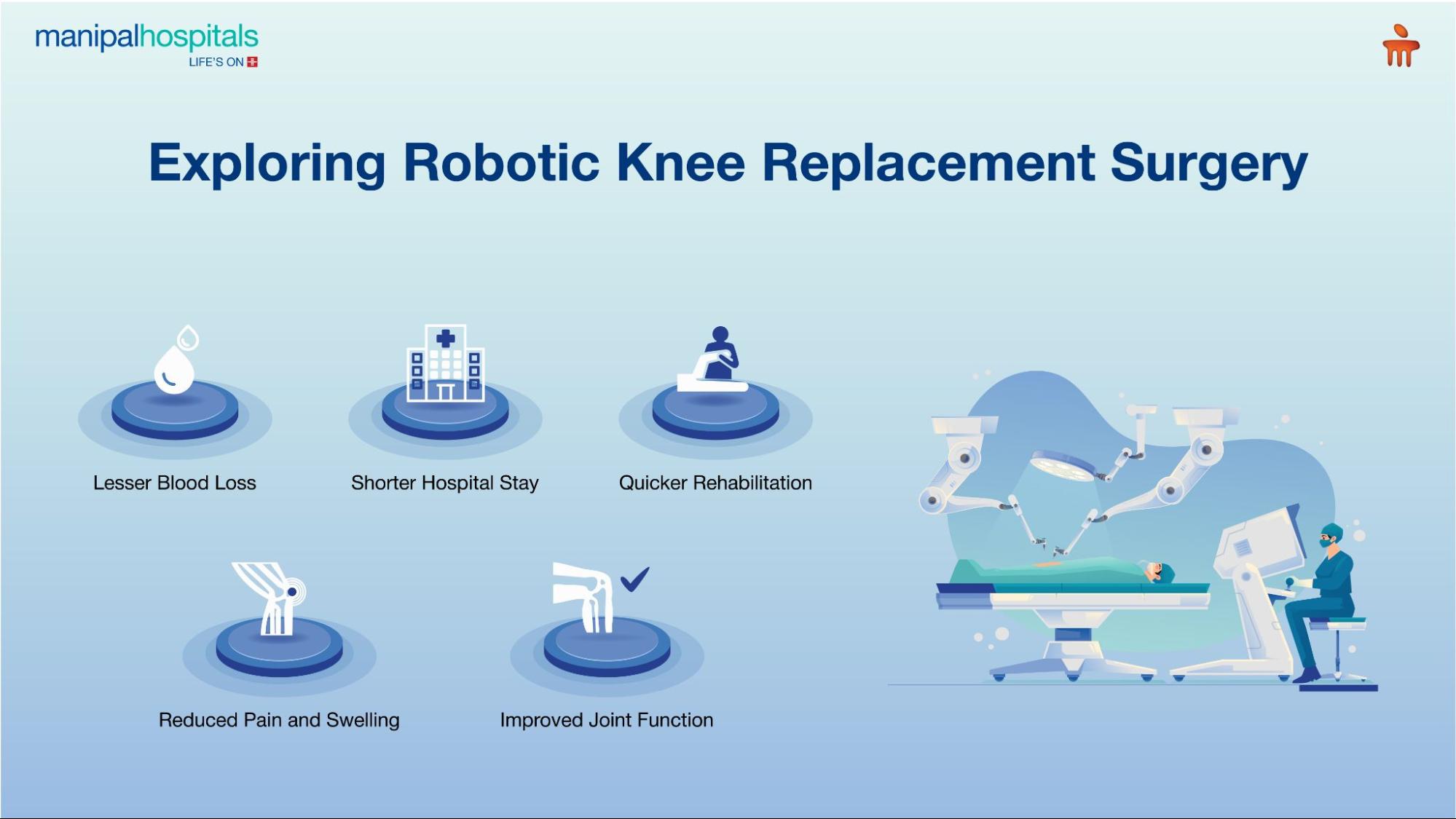
In joint replacement surgery, total knee replacement (TKR) has been a life-changing procedure for abating severe knee pain. However, in conventional total knee arthroplasty, there are challenges related to precise bone cuts and positioning of the prosthesis. In comes robotic TKR, which holds more advantages by providing precision and improving patient outcomes.
At its core, robotic knee replacement works by augmenting the joint replacement surgeon's capabilities.
Synopsis
What is Robotic Knee Replacement Surgery?
In joint replacement surgery, total knee replacement (TKR) has been a life-changing procedure for abating severe knee pain. However, in conventional total knee arthroplasty, there are challenges related to precise bone cuts and positioning of the prosthesis. In comes robotic TKR, which holds more advantages by providing precision and improving patient outcomes.
At its core, robotic knee replacement works by augmenting the joint replacement surgeon's capabilities.
1. Preoperative 3D Reconstruction: Before surgery, the machine creates a detailed 3D reconstruction of the patient's knee. This model provides insight into what causes knee pain, the type of resection required, and how to properly align the knee.
2. Enhanced Surgical Planning: Using this 3D model, specialised software calculates the amount of bone that should be removed and the precise size of the implant needed. Surgeons use this representation to plan every detail carefully:
-
Ensuring minimal bone removal while achieving the ideal fit.
-
Properly placing the prosthetic (metal or plastic) implant in the location for optimal function.
-
Restoring the natural alignment of the leg for balanced weight distribution and improved gait.
-
Maximising contact between the implant and bone for stability and longevity.
3. Intraoperative Guidance and Reduced Injury: During surgery, the robotic device provides continuous guidance to assist the surgeon. This real-time assistance helps to reduce damage to surrounding healthy cartilage and bone tissues.
In robotic partial knee replacement surgery, surgeons remove and replace only the damaged part of the knee (single compartment). Robotic knee arthroplasty has significantly improved orthopaedic surgery by reducing human error and improving patient outcomes.
Also Read: Is Joint Replacement Necessary to Cure Joint Pain?
Benefits of Robotic Knee Replacement Surgery
Here are some of the benefits of robotic knee replacement surgery over traditional total or partial knee replacement surgery:
1. Unmatched Precision and Accuracy: The detailed 3D model of the knee allows your surgeon to meticulously plan the optimal implant size, position, and alignment. Moreover, the robotic arm, guided by the surgeon, makes the bone cuts and implant placement with microscopic precision. This minimises the risk of human error and ensures a perfectly fitted implant, crucial for long-term success.
2. Customised to Unique Anatomy: No two knees are exactly alike. Robotic systems create a highly personalised surgical plan tailored to the patient’s specific bone structure and soft tissue balance. This customisation leads to a more natural-feeling knee joint after surgery, optimising its function and improving range of motion.
3. Minimally Invasive, Faster Recovery: Smaller incisions along with reduced damage to the surrounding healthy tissues enable faster recovery. This minimally invasive approach leads to several direct benefits:

-
Reduced Pain and Swelling: Less tissue trauma means less post-operative discomfort.
-
Less Blood Loss: Smaller incisions contribute to reduced blood loss during surgery.
-
Shorter Hospital Stay: Patients recover faster and stay for a shorter time at the hospital, often going home the same day.
-
Accelerated Rehabilitation: With less pain and tissue disruption, patients can begin physical therapy sooner. They often start walking within 3-4 hours after surgery.
4. Improved Joint Function and Longevity: Robotic technology facilitates the precise alignment and placement of the implant, contributing to better overall joint mechanics. This can lead to a more stable knee, improved range of motion, and a more natural gait. Furthermore, a well-aligned implant is less prone to uneven wear, which extends the lifespan of the artificial joint and reduces the likelihood of future revision surgeries.
5. Enhanced Patient Satisfaction: Reduced pain, quicker recovery, and improved functional outcomes often result in higher patient satisfaction. Patients can return to their daily activities and hobbies much sooner, feeling confident in their newly restored mobility.
6. Reduced Risk of Complications: The precision of robotic knee surgery mitigates implant misalignment, infection, and blood clotting.
Conclusion
Whether you require total or partial knee replacement surgery, robotic-assisted knee surgery offers a less painful, more mobile alternative. While robotic knee replacement surgery is an advanced procedure, it is essential to have a thorough discussion with your joint replacement surgeon when deciding to opt for it.
Our experts at the Department of Joint Replacement and Orthopaedics at Manipal Hospitals, Goa, will help assess your condition and knee pain and advise you on the type
FAQ's
Yes, robotic surgery is often recommended for its precision and improved outcomes compared to conventional knee replacement. It allows for highly customised surgical plans tailored to your unique anatomy.
Robotic knee replacement has a high success rate, often close to 100%. Some reports also indicate up to 98% with expert surgeons, leading to excellent long-term joint function and patient satisfaction.
There is no strict upper age limit for robotic knee replacement. It often depends on a patient's medical fitness and bone quality rather than on their age. Even older, healthier individuals can be good candidates if deemed fit for surgery.
Any individual who has been suffering from debilitating knee pain can find relief with robotic knee surgery. These include individuals with severe bone loss, or patients with severe medical conditions like post-bypass surgery, post-angioplasty, and COPD can consider getting a robotic knee surgery. Please do consult with your doctor on the same.
Recovery time for robotic knee replacement is typically faster than conventional methods, with all patients walking within 3- 4 hours of post-surgery and returning to most daily activities within 4-6 weeks. Full recovery and optimal strength can take a few months.
Robotic knee replacement surgery is considered very safe, as the robotic system enhances the surgeon's precision, potentially reducing complications like misalignment and soft tissue damage.





















 6 Min Read
6 Min Read




















